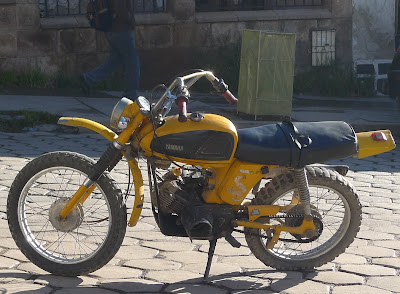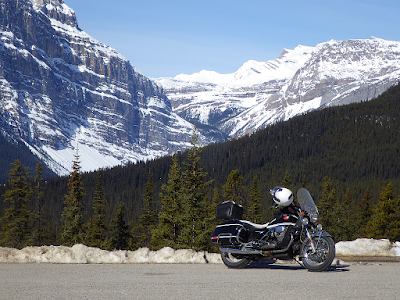The what I learned posts; Choose Your Weapon
If you are going to ride to South America, almost any motorcycle will do, but some will do better than others. Where are you going, and what would you like to see? Central and South America have good roads and bad roads, mountains, plains and deserts. Some areas are densely populated, and in some you may travel for hundreds of miles without seeing a soul. If you are going all the way, you will be racking up many odometer digits, you will encounter every kind of road, including no road, just about every kind of weather short of a blizzard, and you will be gone for months.
We gringos lean towards bigger is better, and too much that is never enough. Choose a bike that is light, 650 cc or less, has excellent suspension, some form of wind protection, can go a minimum of 300 km (200 miles) on a full tank, runs OK on regular gas, has simple maintenance requirements and long service intervals. Low speed handling in tight spots is going to be more important than extended high speed capability, you won't be able to go very fast most of the way.

In heavily populated areas, your average speed will be closer to 60 kmh (35 mph) than 60 mph. The distance between towns is only a few miles, and the road goes right through the center of them all. Speed bumps are used to slow everything down, big trucks and buses will come to a complete stop at each speed bump. Roads are filled with pedestrians, buses, taxis, animals, pushcarts, wheel barrows and street vendors. In 'el centro' you may find yourself threading through an open air market at walking speeds.
Avoid heavy bikes (more than 500 pounds) unless you are an Olympic weight lifter or are traveling with many strong friends. The mere thought of muscling an over 500 pound unladen bike through the sand in Bolivia or the Argentinian mud makes me want to take up knitting for a hobby. Another reason to stay away from heavy and or powerful bikes is tire lifespan, sub 100 horsepower bikes go a lot farther on a set of skins and use less gasoline.
You may need to fix flats or repair damage resulting from tip-overs and crashes. If you are going all the way you will rack up many thousands of kilometers, wear out tires and chains, need to change oil and filters. What service will your bike choice require over this distance? Even if you plan to do your own maintenance and repairs, you will still need access to parts, tools, and a place to work. All information is available on the internet, you can research dealer location, model availability, sources for chains and tires before you leave.
Is your bike sold in South America? If so, parts and service should be easier to obtain. There are many more bikes in Latin America then in most parts of the US and Canada, but not the same makes and models. The typical Latin American two wheeler is a small scooter, standard, dual purpose or cruiser, of 200 cc or less, made in China and sold for the equivalent of between 2,000 and 3,000 US dollars. Japanese brands are well represented, but the models they sell in South America are not the same ones they sell in the US and Canada. Check the internet to see if your bike is sold where you are going. In many South American countries cops ride Kawasaki 650 KLRs. BMW and KTM sell the same models in South America they sell in the US and Canada and have dealerships in in most of Central and South America. I saw a few Aprilias, mostly in Argentina, and the odd Harley, usually a Sportster. Having said all that, if you must ride your Gold Wing or Road King to Tierra Del Fuego, you can probably get away with it, but you will be restricted as to where you can go.

One thing to consider, if your goal is to reach some destination in South America, how important is it that you ride all the way? I spent three months in South America and two months getting there. Riding all the way was the goal for this trip, but I enjoyed South America far more than the stuff that was in between. If I was going back (and it is likely I will) I don't think I would ride all the way again. Flying the bike in sounds expensive, but it will be cheaper than riding it when you factor in that you will be on the road for weeks or months, and you still have to get across the Darien Gap. Flying the bike back from Santiago was not much more than flying it from Panama City to Bogota.
I will also be seriously looking at buying a bike down there and selling it when I leave. The hitch is to find a country that will allow you to register the bike without having resident status.






Comments
Post a Comment